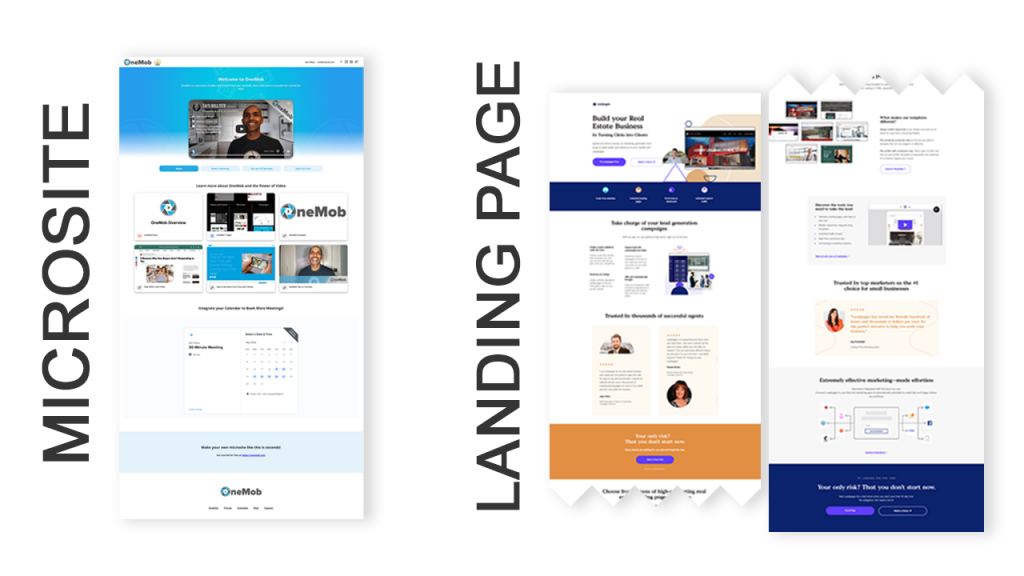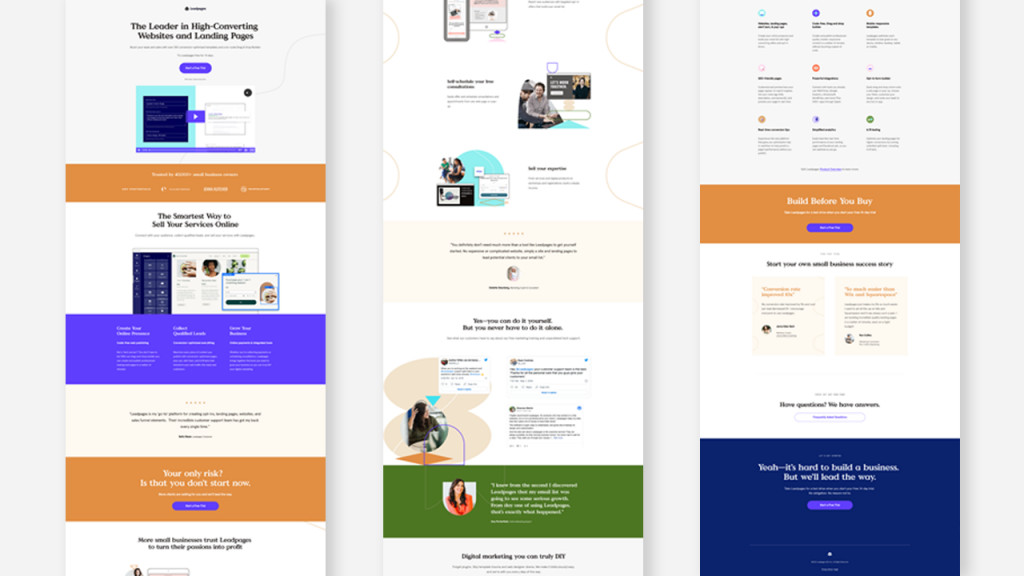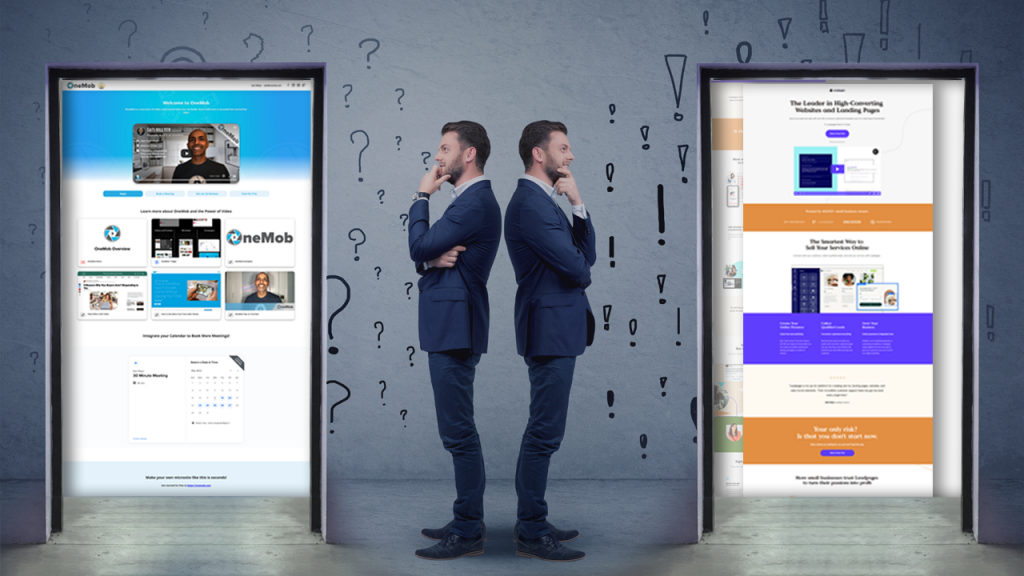Although microsites and landing pages seem similar in certain aspects, they each serve a different purpose for businesses.
As a business owner focused on growing the online presence, regardless of the industry you serve, understanding the differences between microsites and landing pages is essential in guaranteeing your success in moving your business to the digital world.
By learning about these two types of mini webpages, you’re gathering the right knowledge that will increase your chances of successfully marketing your product or service and beating your direct competitors.
This is more important than ever before since…
- There is an information overload online, and as time passes, customers are more confused due to having more options arise.
- Consumers, whether businesses or individuals, slowly move away from physical stores, and move more towards online transactions.
With this in mind, it’s in the best interest of a business to ensure that it’s up-to-date with digital trends.
In this post, we will cover everything you need to know about these two types of miniature webpages, how you can utilize microsites and landing pages to grow your business’s online presence, and how they serve to increase sales.

What are Microsites and Landing Pages?
Microsites and landing pages can be compared to having a physical gallery for your products and services, but they perform exceptionally well for showcasing information.
Galleries will often give you the whole rundown of the services or product, but they won’t contain all of the information the business wants to convey.
With microsites and landing pages, customers are given the information they need to make a valid decision on whether or not the product or service will benefit them.
You can think of landing pages and microsites as online galleries with different sales approaches, and they are used to not only showcase the product or service, but to explain the benefit to the target audience.
It’s important to note that landing pages are loosely tied to the company’s website, and microsites are separate pages from the business’s actual website.
Landing pages are usually designed with the sales funnel approach, which basically presents the content in a specific order down a “funnel”, then moves the visitor to take action at the end.
Although landing pages are sometimes accompanied by an explainer video, most landing pages do not show videos and only rely on text and images to convert the visitor.
Microsites are less “salesy” and are designed to be a content hub where they give the visitor the information they need to see the value in the company’s offering.
Microsites benefit more from informing the potential customer, rather than depending on the customer to make an impulse decision.
Despite having different structures and definitions, both web pages have the same goal of increasing business sales, brand reach, and overall conversion rates of potential customers.

Difference Between Microsites and Landing Pages
To better understand microsites and landing pages, we must understand the differences between them. The two are often confused with each other because they are both used to advertise a company’s products or services.
But remember… the way each of them advertises their products or services is extremely different from one another and they each serve a different purpose.
The main difference between the two is where they exist. Landing pages are an extension of the main website, yet do not have the main navigation bar that might direct the visitor to another page…
… while microsites can exist using a completely different URL.
The differences between the two are very situational and content-oriented, that’s why it’s very easy to mistake one with the other.
A good tip to remember is to review your company’s goals to figure out which one will better suit the situation.
A landing page is a hyper-focused page that is specifically meant to entice viewers to take action, such as downloading, joining up, paying, or performing some other activity.
It isn’t linked to your website’s navigation, and it isn’t connected to anything that can send your visitors away.
Microsites are useful in situations where you need to promote a product or service by backing it up with supporting content;
Or even to promote a new product or service that has a different target demographic from the main website.
It’s safe to say that a microsite’s conciseness is a big part of what makes them so appealing.
However, they’re detailed enough to entice the reader to click and learn more about the product on the following pages.
In addition to all of this, microsites will aid in increasing your website’s organic traffic.
Benefits of Using Microsites
There are a lot of reasons why you should consider utilizing microsites to market your business online.
Having a good website isn’t enough to succeed in the digital space.
In order for your business to thrive in this space, you must understand the cards you have to play with. One of these “cards” can be a microsite. There are numerous benefits that can be acquired by implementing a microsite.
We have created a list inspired by an amazing article by Nida Zehra, which explains the benefits of using microsites, which are:
- Increased brand reach
- Leads for business
- Ability to promote targeted content
- Search engine optimization (SEO)
These are just some of the many benefits.
Another important benefit of using a microsite is its opportunity to go viral through designing and promoting high-quality content.
7 Disadvantages of Microsites (With One Solution For All)
There are pros and cons to using microsites and landing pages.
Despite its advantages, it’s important to acknowledge the disadvantages that come with using microsites, in particular.
Here are the 7 main disadvantages of using microsites:
- Building and deploying a microsite takes more time than doing so for a landing page.
- Their upkeep takes more time, effort, and money.
- Microsites’ ROI is difficult to estimate.
- There is a need for additional domain names.
- Less interaction with your main website.
- Might drive traffic away from your website
- The need to develop a new marketing strategy.
Fortunately, there is software made to help businesses and individuals create a microsite and not break the bank…

The OneMob Solution
OneMob is an online tool designed to help businesses and individuals build unique microsites that help them engage and build rapport with their audience.
OneMob is used by a wide range of businesses and individuals, from salespeople and recruiters to consultants and online influencers.
OneMob is the solution to all of the disadvantages associated with traditional microsites. Let’s get straight to the point with its solutions:
- Requires no coding skills.
- No setup work. It’s all ready to go.
- It offers a freemium version, as well as a low monthly fee subscription.
- It is easy to use and easy to maintain.
- Allows users to manage their campaigns.
- Doesn’t require a separate domain name.
- Offers insightful analytics on how your audience engages with the content.
Don’t believe me? Sign up for the free trial and see for yourself.

Benefits of Using Landing Pages
As previously mentioned, taking in the benefits of using microsites and landing pages is crucial to ensuring your business adapts to this new digital age.
With this in mind, let’s talk about the benefits of using landing pages for your company.
The most expected benefit of using landing pages is to increase conversion rates.
According to the web analytics company Omniture, advertisements that integrate landing pages experience a 25% increase in conversion rates. Businesses are quickly adding landing pages to their online profiles to get ahead of the competition.
Businesses recognize that landing pages serve as the gateway toward selling their company’s products or services.
So, they make sure that these pages appear online and present their businesses in the most flattering way possible to make sure that users have a great first impression.
Here are some of the benefits of using landing pages:
- The setup takes very little time.
- It is not necessary to purchase additional domain names.
- There is no need for a lot of upkeep.
- They’re excellent at getting people to convert.
- In most cases, they don’t require big budgets.
- The use of UTM tags and short link services enables you to quickly calculate the return on investment (ROI).
Disadvantages Of Using Landing Pages
However, there are many disadvantages to using landing pages. Some of the most common disadvantages of using landing pages are:
- Slow page speed due to multimedia elements.
- Expensive to market.
- Limited Content Opportunity.
- Not as engaging as microsites
- Many people aren’t satisfied with the information they receive from them.
- They cannot be a replacement for website, whereas microsites can.
Don’t worry, if you’re still considering using this method to advertise your company, here’s what you can do to encourage its success:
- Keep it in line with your ad campaign.
- Keep it mobile-friendly.
- Make sure your landing page does not take more than 3 seconds to load.
- Add persuasive web copy.
This section of the article is not meant to discourage you from using landing pages.
Rather, it should give you insight into what to expect so that you can watch out for certain roadblocks that might

Why Should You Use a Microsite or a Landing Page?
Still unsure of whether you should use any of these two types of web pages for your website?
In this part of the post, we will go over the reasons why you should consider using microsites and landing pages to boost and advertise your company’s services.
One way to gain website viewers is by using targeted advertisements through the use of microsites or landing pages.
Before creating either one, think about the user’s experience and think about its applicability to the overall ad campaign.
To put it simply, landing pages limit the distractions that regular websites can cause. They make sure that the webpage visitors are viewing is targeted and catered to the specific message the company wants to convey.
Decluttering your main website with either of these two web pages mentioned will encourage your customers to quickly determine whether they need to purchase your products or services.
How to Choose Which One to Use for Your Business Needs
When choosing which one to use, it’s important that businesses understand what they need, versus what they want.
Understanding the gaps in your company’s online presence can go a long way in ensuring that you choose the right option for your business.
Twenty Over Ten’s chief marketing and business development officer, Samantha Russell, advises brands to base their choice on their specific objectives.
There is no “copy and paste” solution in the world of marketing, and every plan needs to be custom according to your company’s goals.
Businesses should utilize landing pages when:
- Encouraging users to take a single action.
- Promoting affiliate products.
- Attempting to sell a product or service.
- Gathering market research and feedback.
- Trying to increase sales in the fastest way possible.
Businesses should utilize microsites when:
- Trying to segment or differentiate a product or service from the main offering.
- Advertising a single and specific product or service.
- Educating the audience about their business.
In summary, landing pages are suitable for one-off campaigns.
Microsites are more complex, but they’re better for long-term campaigns and create an experience beyond just selling products or services.
To Wrap It Up
As you have learned in this article, there are a lot of factors that need to be considered when choosing between microsites and landing pages.
Having a deep understanding of what your business requires is essential to making sure that you are choosing the right option for your marketing needs.
Whether it be in the physical or digital world, your choices will always have a great impact on the success of your endeavor. To summarize this article in the most concise way possible, consider your company’s needs when deciding between creating a landing page or a microsite.









